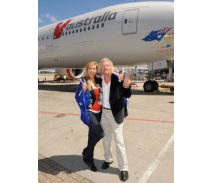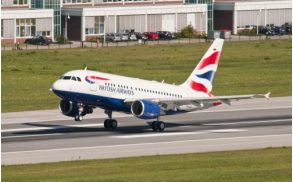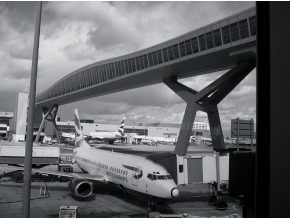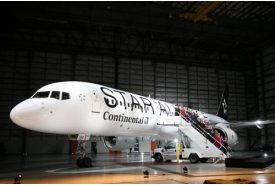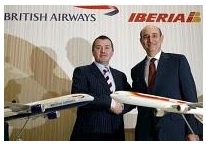2009: The Highs and Lows
US welcomes boutique airline
Virgin Blue's international airline, V Australia, had its first successful year in operation after starting up a Sydney (SYD) to Los Angeles (LAX) service in February, adding competition to a route dominated at the time by United Airlines and Qantas. The carrier has also successfully expanded from key Australian cities where it also serves Phuket (HKT) and Nadi (NAN) and is hoping to launch Johannesburg (JNB) early this year. US destinations will be served through Los Angeles using a Delta Airlines codeshare.
Fleet of bankruptcies
The number of airline bankruptcies in 2009 took a domino effect; as one collapsed, shortly after, another. Slovakia-based SkyEurope folded in June after struggling with the fall-off in passenger numbers, while Russia's debt-ridden KD Avia declared bankruptcy in September and JAL, which is still seeking a bail-out to avoid impending bankruptcy continues to make the headlines. Scottish budget operator Flyglobespan and Air Comet were also lost in December.
AirAsia X lasts the distance
In March, AirAsia X became the fourth no-frills carrier to try serving the long-haul market, launching a direct service between London Stansted (STN) and Kuala Lumpur (KUL) - succeeding where others failed. (Low-cost Laker Airways' bankruptcy in 1982 lost the world's first low-cost transatlantic service and more recently, budget carrier Oasis Hong Kong Airlines collapsed in April 2008, along with its London Gatwick-Hong Kong service and UK-Canadian Zoom Airlines followed in August). Today Air Asia is offering seven flights a week using an A340 aircraft.
However pessimists will argue that the long-haul low-cost business model is flawed, due to limited opportunities to reduce cost over competitors with aircraft costs and fuel accounting for a large proportion of overheads.
AirAsia X has lasted this long in a difficult market because it is an established brand with values that the consumer will buy into. Secondly Air Asia has a base to feed the operation and thirdly the airline has been set up with a small management team with functions resourced cheaply from its parent.
BA attracts high-flyers
Despite announcing its biggest ever operating loss of £401 million in May (largely due to the slump in premium traffic, BA's core business), BA boss Willie Walsh bucked trends with an exclusive, all-business class service between London City Airport (LCY) and New York JFK, designed to attract custom from the capital's wealthy city banker and lawyers. Launched in September, the new concept appears to have been an overnight success and in October, BA launched a second daily service.
The average yield (one-way) for the London City- New York JFK market is over USD 1373, which is higher than the average one way yield for the London Heathrow to JFK market.
The service is offered using a configured A318 aircraft, with 32 seats onboard. The route makes a short stop in Shannon (to refuel and provide US immigration clearance in Ireland).
Gatwick's competitive landscape
The sale of Gatwick airport to GIP (Global Infrastructure Partners) for £1.5 billion in December puts an exciting spin on competition between London's airports. Sir David Rowlands, the newly-appointed Chairman of Gatwick's Board, said: "Gatwick is now a major independent airport company and from today, for the first time ever, it is competing directly with Heathrow, Stansted and Luton, as well as with our other airport, London City, in a competitive London airports market. We will be competing vigorously against all London airports for point-to-point, short-haul and long-haul routes and passengers."
The question for 2010 will be whether Gatwick can make an impact on the increasingly more established alliance carriers at Heathrow?
Spanish "merger of equals"
The merging of loss-making rivals Vueling and Clickair created the largest single low-cost carrier in Spain - described by Vueling CEO Alex Cruz as "a merger of equals." Consolidation of ground services and fleet rationalisation has transformed the airline, which recorded an operating profit last year.
As both carriers were based in Barcelona, the network could be easily consolidated and the question for 2010 is how far will they expand into Madrid, given that Iberia now has a vested interest in the new carrier?
The new Vueling now operates 1037 weekly flights from Spain, while Ryanair has the biggest presence in the Spanish market, with 1364 weekly flights. easyJet operates 598 (figures from Dec 1-7 2009).
Ryanair's high profile exit
In August, Ryanair's decision to pull nine of its ten routes from Manchester airport in a disagreement over charges meant the loss of 44 weekly flights. (One month earlier, Ryanair also cut some winter services from Stansted airport after a dispute over landing charges). Instead Ryanair has turned its attentions to East Midlands, Liverpool and Leeds Bradford (and a new base). While Manchester airport plugged the gap with Jet2 and Flybe.
Short-term strategies
In September easyJet announced it would pull its base in East Midlands (EMA). Jet2.com was quick to step in, announcing a base there. Shortly after, easyJet announced a base in nearby Doncaster (DSA). This opportunism was also seen in Basel, where Ryanair pulled out of the airport and easyjet quickly moved in to establish its own base.
Continental switches alliance
Continental Airlines became the first major airline to switch membership in an alliance - breaking ties with the SkyTeam and joining the Star Alliance in October. The carrier now provides the Star Alliance with one of the most important markets in the world: New York's Newark Liberty International Airport (EWR), as well as providing passengers with increased access to Latin America.
Continental offers the 71-weekly flights from the US to Latin America. The next largest Star Alliance member is United Airlines, which offers 21 weekly flights.
BA-Iberia tie-up
In December BA (which already has a 13.5% stake in Iberia) took its codeshare position with Iberia a step further, reaching a preliminary merger agreement which would see BA hold a 55% stake in Iberia (with Iberia holding 45%). The result: "a strong European airline with BA at the heart," said CEO Willie Walsh. The codeshare is still subject to final government approval and as well as cost savings, the loss-making carriers would be able to share 419 aircraft and 205 destinations.
US Airways realigns business
The carrier announced that a string of transatlantic services to Europe would be suspended due to falling demand: London's Gatwick Airport (LGW), Birmingham (BHX), Milan, Stockholm (ARN) and Shannon (SNN). In addition, frequencies were squeezed from Las Vegas and a service to Colorado Springs dropped as 2009 became a year to restructure and position itself for long-term recovery. Flights instead are concentrated around three bases: Charlotte, Philadelphia and Phoenix.
Caribbean loses capacity
The Caribbean market suffered when American Eagle pulled 37 destinations from San Juan, including its Puerto Rico base. Jetblue has since been the leading carrier backfilling capacity on Puerto Rico market.
Data Source: IATA BSP DATA (AIRPORT IS)
